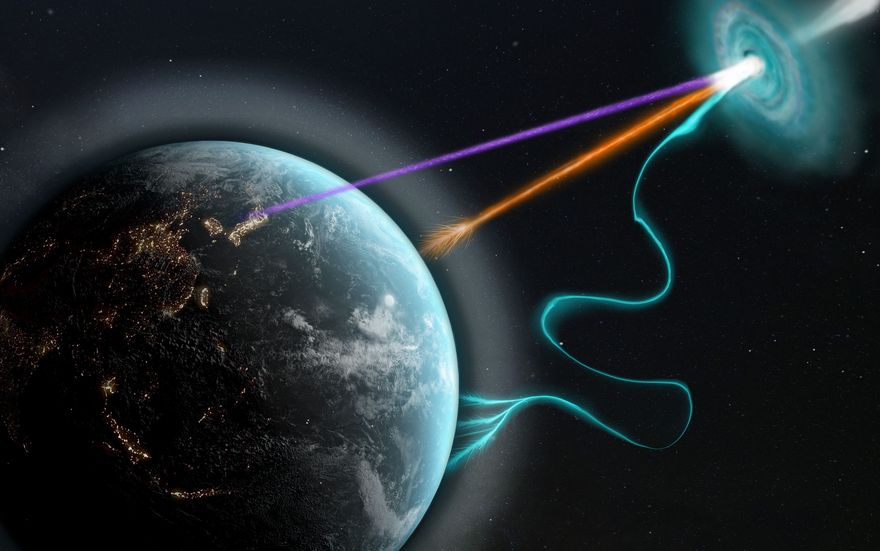Astrophysical Messengers
Modelling and analysis of energetic astrophysical particles
The Universe has long been studied using optical light. More recently, this view has been expanded to include the complete electromagnetic spectrum, from radio to gamma-rays, unveiling a Universe of energetic and diverse sources that can be analyzed from vast distances and early epochs. Astrophysical particles — cosmic rays and neutrinos — have also been added to the messengers that can be used to investigate the cosmos.
Our research concerns the most energetic astrophysical particles. In order to detect these rare messengers, researchers use detectors monitoring the Earth’s atmosphere, ice sheets, and oceans. Cosmic rays are charged particles, i. e. protons and the nuclei of heavier elements, that have been accelerated to high energies. While we can detect cosmic rays up to ultra-high energies, their origins are unclear. Charged particles interact with their environment as they travel toward the Earth, leading to energy losses and deflections in magnetic fields, which make it challenging to localize their origins. Possible sources capable of accelerating particles to extreme energies include gamma-ray bursts, active galactic nuclei, blazars, and galaxy clusters.

The interactions of cosmic rays with matter and radiation fields along their path lead to the production of gamma rays and neutrinos. These electrically neutral messengers can travel undeflected to Earth and provide complementary information. However, the interpretation of these observations presents further challenges. Gamma rays can also be produced by non-hadronic processes that must be disentangled from signatures of particle acceleration. Neutrinos are a direct sign of hadronic processes but are weakly interacting and not easily detected. Combining the observations of these messengers will provide a detailed new view of energetic astrophysical objects and a laboratory for studying particle physics at extreme energies.
Today, there are large-scale experimental efforts in place, meaning that there are many relevant data sets available. For example, the Pierre Auger and Telescope Array ultra-high-energy cosmic ray experiments and the IceCube neutrino observatory have collected rich data sets over 10 to 20 years of operation. In the field of gamma-ray astronomy, the astrophysical messenger group will co-operate with the MAGIC and CTA groups at the MPP. Our goal is to develop advanced statistical analysis methods to exploit the available data to its full potential and gain a deeper understanding of the possible sources of these energetic particles. These new approaches focus on complementing existing efforts by enabling a closer connection between theory and data and effectively combining information from different observations.
Group "Astrophysical Messengers"
Phone number: +49 89 32354-extension
| name | function | extension | office | |
|---|---|---|---|---|
| Bourriche, Nadine | PhD Student | nadineb | 561 | A.2.07 |
| Capel, Francesca, Dr. | Senior Scientist | capel | 417 | A.2.09 |
| Kuhlmann, Julian | PhD Student | kuhlmann | 561 | A.2.07 |
| Saurenhaus, Lena | PhD Student | lsaurenh | 561 | A.2.07 |
Bayesian constraints on the astrophysical neutrino source population from IceCube data
Capel, F., Mortlock D. J. & Finley, C.
2020, Physical Review D, 101, 123017
DOI: 10.1103/PhysRevD.101.123017
Impact of using the ultra-high-energy cosmic ray arrival energies to constrain source associations
Capel, F. & Mortlock, D. J.
2019, Monthly Notices of the Royal Astronomical Society, 484, 2324.
DOI: 10.1093/mnras/stz081
